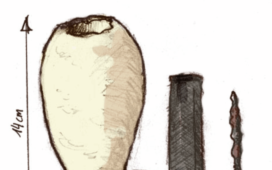A murmuration of tens of thousands, perhaps hundreds of thousands, of starlings, flying in such perfect synchrony that they look like a single, billowing, pulsing organism against the night sky: this is one of nature’s most striking sights. The biggest evolutionary benefit of moving in concert is obvious. A coherent collective serves as a deterrent, since it’s far more difficult for a bird of prey to attack such a group than a lone bird. What is harder to explain, however, is how a collection of individuals – as many in number as the population of a medium-sized Swedish town – is able to fly with this kind of coordination, which both retains the flock’s soft malleability and keeps it from breaking into smaller groups that would be easy prey for a hungry peregrine falcon. Anyone who’s ever done a group project and seen firsthand how complicated it is to get even five people to march in the same direction will realize that the management structure for a group this size would need to be highly complex. But there are no ethological observations to indicate that a murmuration’s collective will is dictated by one (or several) individual(s) in leadership position, and in any case it’s difficult to imagine how such far-reaching orders could be conveyed, considering the fact that the murmuration, when a threat appears, must make and execute a coordinated decision with minute precision and in a fraction of a second. The opposite of a hierarchical leadership structure is a completely flat organization, where all the flock’s members communicate with each other simultaneously, coming to a collective decision about flying speed and direction. The problem with such an arrangement is that it requires every individual to exchange information with everyone else, which in a murmuration of tens of thousands of starlings would require the transmission of an unfathomably large number (in fact, hundreds of millions) of ‘messages’. In other words, a completely flat organization of the flock would be unreasonable for any group bigger than ten or so individuals. No, it would seem as if evolution must have arrived at something in between these two extremes: an organizational model where every individual coordinates their own movement with just a small part of the flock. The question is if – and if so, how – such a local organization of individuals can create a flock that’s coordinated as a whole, even when it can measure tens of meters in diameter. To explain how this works, and why a chemist like myself has come to take an interest in something as biological as starlings, I will, for a moment, change topics to talk about the kinds of things chemists normally spend their time thinking about: atoms, molecules and thermodynamics.
A common (if not unique) characteristic of everything we call life is that it has a direction, either in the spatial sense, like the cheetah who runs in a graceful arc toward the fleeing antelope, or temporally, like the tree crowns that periodically change their colour throughout the year. In sharp contrast to these forward-pointing, dynamic processes is the directionless, unmoving existence of dead things. A stone lies where it is until you pick it up and toss it. But ever since the discovery of atoms, and especially since the invention of the microscope, we’ve known that dead things are in fact in no way unmoving. The molecules in a glass of lukewarm tap water in fact speed around at a velocity of 2,000 kilometres an hour, colliding with each other millions of times a second. This chaotic, directionless movement, however, is of a fundamentally different character than the one-directional forward-motion we associate with living organisms. In order to describe the difference between life’s direction and death’s chaos from the viewpoint of a thermodynamicist, we first need to introduce the term equilibrium.
In the everyday use of the word, equilibrium tends to characterize a harmonious state of being in balance and comfortable with one’s surroundings. Similarly, equilibrium in the scientific context refers to a state that is, in some ways, peaceful and static. The toast on the edge of the kitchen counter is in mechanical equilibrium until you push it. When it lands on the floor (most likely, of course, jam-side down) it once again reaches mechanical equilibrium, as the upward force of the floor perfectly counters the downward force of gravitation. Likewise, equilibrium in the thermodynamic sense means that all heat and matter flows, and all chemical reactions, are perfectly balanced, so that the system’s temperature and chemical composition remains unchanged over time. The system exists in a resting state without movement or direction. If you film the movements of molecules in a glass of water and show it to somebody ever so knowledgeable, they still won’t be able to determine if you’re playing the film forward or in reverse. This might seem like a desirable, harmonious state to achieve also as a person, but in actuality, life requires constant movement to avoid reaching equilibrium. Life requires direction and order at both a macroscopic and microscopic level, which means that life always needs to unfold far from the equilibrium state.
When you bend your arm, the muscles contract as thousands of molecular ‘motors’ contract the muscle fibres in one direction through a synchronized movement. This is a molecular movement with a clear direction in both time and space, in contrast to the chaotic, directionless state of equilibrium. This establishment – and maintenance – of life’s directed, well-organized machinery in an environment that strives toward equilibrium and disorientation, can only be achieved at the cost of great amounts of energy, stored in the form of chemical bonds derived from everything we eat.
Our body can be likened to a car with malfunctioning brakes standing on a steep incline, with the driver pushing the pedal to the metal to keep it from rolling down the hill. Gravitation can be fought as long as the engine is howling, but the instant the fuel runs out, you’ll start backsliding, down toward the chasm. The moment our bodies stop freeing energy from what we eat, drink, and breathe, we’re caught by the inevitability of thermodynamics. Our bodies slowly start their journey toward equilibrium, transforming a well-ordered machinery of proteins and blood vessels, toe nails and hormones, into a few kilogrammes of carbon dioxide and a few litres of water.
Our bodies, like all living things, have the ability to channel energy stored in the nutrients we ingest, and to build, from fairly simple building blocks, an incredibly well-organized system that performs tasks with direction and purpose. This is in contrast to most dead systems, where the energy input often represents a destructive force. If we could take a snapshot of the molecules in a glass of water, we would be able to see a fairly well-ordered system, where every water molecule creates strong bonds to its four closest neighbouring molecules. Next, if we transfer the water to a pot on the stove and add energy from the heat of the burner, the molecules will begin to vibrate and move with increasing speed. Once the water nears the boiling point, the molecules will shake with such intensity that the bonds linking every water molecule to its neighbour begins to break, and when the temperature reaches 100 degrees Celsius, the energy stored in the bonds will no longer be enough to hold the molecules together as a liquid. The water molecules tear apart and the water begins to boil, transforming into steam. In other words, our sensorial experience of heat is directly linked to the power of the destructive force causing disorder on the molecular scale. Temperature can, in this way, be viewed as a measure of molecular chaos: an increase of the temperature from 99 to 100 degrees creates an abrupt transition – a phase transition – from a relatively well-ordered system, where the water molecules are closely bound into a liquid, to chaotic and dispersed steam, where the molecules fly alone through the ether.

A starling murmuration, Scotland, 2020. Image by Walter Baxter via Wikimedia Commons
To bring us back to the organizational structure of the starling, let us picture an infinite lattice of tiny, magnetic compass needles, each able to rotate freely about its own axis but otherwise fixed to its position in the grid. Let’s ignore, for now, the Earth’s magnetic field, so that no individual needle prefers to point in any particular direction in space. It will, however, attempt to direct itself toward the magnetic fields emanating from its neighbors in the grid, which would lead the needles to point in the same direction. These neighbors also rotate freely, and try, in turn, to point to the magnetic field of their closest neighbours. As a result, the desire to point in the same direction propagates through the lattice. Since our compass needles are very, very small, in addition to their drive to point in the same direction as their neighbour, they’re also affected by the same chaotic, molecular motion as the water molecules, now in the form of a random rotational motion around their own axis, as they’re still nailed to the spot in perfectly straight rows. This creates a balance between a force that seeks to create order (adjacent compass needles want to point in the same direction) and a force that wants to destroy order (chaotic rotation). Finally, we’ll free each magnet from its position in the grid and give it a directed forward-motion as where the compass needle points. We’ve now moved from a model of compass needles on a grid – known, in physics, as the XY model – to a highly simplified model of birds in a flock, in which each individual flies in the direction set by its beak, while simultaneously trying to adjust its direction to that of its closest neighbours. ‘The temperature’ in this context should be interpreted as a general uncertainty in the single bird’s directionality. For instance, every individual will be unpredictably affected by the wind, by measurement uncertainty when interpreting the direction of its neighbours, and by imperfections in the setting of its own ‘rudder’. In the moment that these stand-ins for birds are given the ability to fly in a given direction, we’ve taken the system out of equilibrium. Now we can clearly see a difference between a recording played forward and backward, which we could not do with the magnets in the XY model.
This way of reducing highly complex systems into almost childishly simple models that can be described in just a few lines is an example of physicists’ reductionist view of the world. Rather than depicting each bird as an individual with wings, sensory organs and evolutionary instincts, the physicist reduces it to an agent governed by a minimal set of simple rules which are, hypothetically, enough to create a primitive flock. With a bit of luck, this model will be just sophisticated enough to recreate the basic phenomenon we’re trying to describe, at the same time as it’s still simple enough to be picked apart using the mathematical toolbox of physics. Such a view of science can often lead to strange leaps of thought – like the one above – where two apparently unrelated systems can both be described using models made up of essentially the same basic ingredients. Using this basic philosophy, we can employ the same vocabulary of concepts to describe the hardness of metals, the evolution of the NASDAQ index, the outcome of the US presidential election, and a murmuration of starlings – which, in turn, has produced a wealth of insights around general driving forces and principles in both nature and human civilization. This method has also resulted in a scientific culture shock or two, as well as some pure follies, as the reductionist scientists willfully, and at times with a level of self-confidence close to arrogance, toss out lots of interesting aspects of physical reality – aspects that have been discovered through decades of hard work by biologists, economists, political scientists and engineers.
In the case of our naïve model for birds in a flock – named the Vicsek Model for the Hungarian physicist Tamás Vicsek, who developed it – it turns out that the combination of a forward motion and a drive to fly in the same direction as your closest neighbours is enough to create a phase transition from a chaotic system, where birds fly in every direction, to a well-organized murmuration, as long as we sufficiently reduce the strength of the chaotic rotation – ‘the temperature’. In other words it is, at least in principle, possible to create a coherent, coordinated group with information about direction and exchanged only locally, which is a requirement to keep the flow of information within the flock at a reasonable level. Interestingly, the directed, life-like movement that brings the system out of equilibrium in the Vicsek Model is absolutely necessary to create an organized flock: in the lifeless XY model it is not possible, no matter how much we reduce the temperature, to create a state where all fixed compasses point in the same direction.
The word ‘flock’ or ‘herd’ tends to have negative connotations: a ‘blind’ group of individuals who, lacking an obvious strong leader, can be manipulated into submission or used as a tool for malicious ends. In actual fact, there is great strength in the leaderless group, precisely due to their inherent flexibility and resistance to external threats. Because each individual is dependent only on its immediate surroundings to know how to navigate, the group as a whole can quickly parry if a bird of prey manages to get its claws on one of its unfortunate brethren. Not even if the flock were split in two by a coordinated attack would the damage be great; because the murmuration’s organization sits in each individual and its immediate neighbours, both parts can quickly organize into two independent flocks without having to determine a new leader. This decentralized organization is so powerful in its apparent simplicity that it has become a buzzword in the scientific field known as swarm robotics. Let’s say that we want to construct a large number of drones and use them to survey an area to determine whether a potato field needs to be sprayed with pesticide or not. Dividing the labor such that each drone reports upward in the hierarchy to an (electronic) decision-maker requires too much work for the latter, and moreover, the entire system will fail if the leader’s contact with the ‘worker drones’ is interrupted. But if this drone swarm, like the murmuration of starlings, can instead build up a decentralized organization that processes information collectively, it can keep working without disruption even if one or a few drones runs out of battery or collides with a powerline.
If the fully decentralized, leaderless group is so powerful, why do we humans use middle-managers, generals and presidents to organize our societies? Most people who have participated in the labor market know that managerial roles dismayingly often attract people with dubious motivations and lacking leadership skills. In the best-case scenario, this can lead to a self-organized, informal organizational structure where the group is able to manage the effects of the boss’s shortcomings, but sometimes it leads to a single-point failure which, in the worst-case scenario, can collapse the entire organization.
As history has shown, however, the opposite of centralization isn’t free from trouble either. Many movements have posited a well-construed, non-hierarchical social organization as their goal, but it has proved challenging – to put it mildly – to realize this dream in practice. Over time, fully non-hierarchical movements tend to either fall apart in factional struggles, or transform into more traditional, hierarchical organizations. At times they’ve degenerated into pure despotism. Humans, as agents, appear fairly ill-suited to following the type of rules needed to create large, truly decentralized groups that can (and want to) remain stable over time. To build a moon-lander, win a handball game, or rule a country might simply require some kind of formalized leadership to avoid strongly developed informal leadership. This asymmetry exists on a local level, too, just as in the murmuration of starlings: the glue that bonds me to my immediate neighbours in the flock is, on a basic level, our relationships and social interactions, and these are never as symmetrical, mechanical, or egalitarian as in the flock models.
* * *
But even though humans, as social beings, seem to gravitate toward a more specialized, and therefore less egalitarian, organizational structure than the murmuration of starlings, we, as biological individuals, are nevertheless fully dependent on decentralized organizational principles. One of the clearest examples is how our consciousness comes into being. At a macroscopic level, all our sensory and motor functions and everything that makes us humans are controlled by the brain, which is both fragile and energy-consuming. The human brain represents about 20% of our energy consumption, despite making up no more than about one percent of our body weight. The brain’s internal structure and evolution, however, is a good example of the same decentralized organizational structure as the one that controls the starling flock.
When the brain of a fetus develops, every single nerve cell creates thousands of connections or synapses to adjacent nerve cells, each representing, in this way, a waystation inside an infinitely complex network. The singular neuron, however, has no awareness of its own function in this machinery but interacts only with its closest neighbours in accordance with relatively simple rules. A chemical signal is detected by the synapse, which activates an electric impulse that gets passed on along the length of the nerve cell, with a new chemical signal generated at the other end. This, in turn, is detected by the next nerve cell, and in this way the message is forwarded through the brain’s highways, forks and dead ends. Some of these hundreds of millions of connections will, with time, turn out to be less frequently used than others, and as the brain learns new skills, unimportant connections will be removed as the remaining synapses grow stronger. The brain’s winding network, therefore, holds the same advantage as the murmuration of starlings: despite, or rather, thanks to the fact that every agent follows only simple, local rules, a whole emerges that is malleable but also resilient. The flock can react swiftly to an impending threat without falling apart, just as the brain (and the rest of the body) can learn to crawl, speak French and solve quadratic equations without being hindered by the death of singular nerve cells.
Though the Vicsek model can teach us something about the basic ingredients that, on paper, are necessary for creating a coherent flock, such theoretical exercises aren’t worth much without confirmation from some kind of experiment. Since it is difficult – even putting animal rights issues aside – to shut a flock of thousands of starlings inside a lab, a fairly spectacular ornithological field experiment was conducted during a number of winter weeks in 2005 and 2006. A group of physicists mounted a large number of cameras on the roofs near a popular roosting site for starlings in Rome, and recorded the movements of numerous starling murmurations. The videos were processed by image analysis software, reconstructing a three-dimensional image of every bird’s position, speed and direction at every moment, which could subsequently be analyzed and compared to the model’s predictions. The resulting findings were both unambiguous and notable. The analysis showed that every singular bird, at every singular point in time, adjusts its direction of flight according to its seven closest neighbours, regardless of the total number of individuals in the flock. Despite this local organization, all data showed that the birds’ direction of flight was coordinated across distances comparable to the flock’s size – regardless of whether the flock measured ten metres or a hundred metres in diameter. In other words, it seems that it is enough to adapt one’s direction to one’s seven closest neighbours to create a coherent but flexible flock of essentially infinite size! The key to understanding how this happens is – again – found in thermodynamics.
In a pot of water just below boiling point, right before the phase transition from liquid to steam, the organizing force of the bonds between the molecules can barely counter the destructive vibration created by the heat from the stove. The pot of water is in what is known as a critical state, where the system is extremely sensitive to perturbations. A minor inhomogeneity in the transfer of heat from the burner will lead to a local fluctuation in the temperature, which, in turn, leads to the creation of a minuscule gas bubble. At a lower temperature, farther from boiling point, such a local perturbation would have affected only the adjacent molecules, and would hence have been quickly suppressed. When the state is critical, however, the perturbation spreads, lightning-fast, through the bonds between the water molecules and then back as a tremor through the entire pot. In the critical state, right on the threshold to a phase transition, the entire system is tense and maximally sensitive to fluctuations, an apparently very fragile and uncertain site for anything to exist in.
Transposed to the starling flock, such extreme sensitivity is in fact beneficial, especially if we consider that the ‘perturbation’ in this case often arrives in the shape of an attacking bird of prey. If the group is in a critical state, information about a small change in the flight direction of a few individuals at the edge – whether this occurs randomly or in order to avoid an attack – is transferred throughout the flock in an instant, even if it’s made up of a hundred thousand individuals. The hypersensitivity that occurs at ‘criticality’ – a somewhat abstract term that describes how materials behave close to phase transitions – turns out to be an incredibly powerful organizational principle that allows nature to create and maintain a flexible, malleable group of living, autonomous individuals in the absence of central rule and middle-managers. Indeed, we can observe this obvious signature of a system on the critical edge between order and chaos not only in starling murmurations but also in the intricate neural networks in our brains. But unlike the pot of water, neither the starling flock nor the brain is controlled by a stove knob capable of minutely adjusting the temperature to 99.9 degrees Celsius for maximum sensitivity. Instead, nature’s criticality is self-organized: it appears spontaneously, a result of evolution slowly molding both starlings and nerve cells to organize themselves as if they were water molecules in a pot of water right at boiling point – yet another strange example of life’s thermodynamics.
What, then, can thermodynamics tell us about what life is? The ability to maintain, over time, a state far from thermodynamic equilibrium might be characteristic of all living organisms, but that doesn’t mean that all non-equilibrium systems are alive – far from it. The Gulf Stream has upheld its one-directional flow far from thermodynamic equilibrium for centuries on end, fuelled by energy from the rays of the sun, to take just one example. Many wise people have tried to formulate sophisticated, and sometimes cumbersome, definitions of life, entirely or partly using a thermodynamic vocabulary. But arriving at a single satisfactory definition turns out to be difficult: on the one hand, it risks including phenomena most would agree are not examples of life; on the other hand it risks excluding life forms so far unknown to us, whether they’re artificially created, extraterrestrial, or simply undiscovered by humans. For this reason, most attempts at a comprehensive definition of life tend to result in a list of features (metabolism, evolution, reproduction, complexity, self-organization, etc.) designed to squeeze in every single life form we know. And even if all these attempts were to result in a comprehensive checklist for what life must contain, it’s not obvious what such a list could really teach us about the world, other than the fact that ‘life’ is a complex, multidimensional phenomenon – when we all already have a clear, intuitive sense of what constitutes life.
Perhaps all we can do is accept that the nature of life is difficult to define. Life can – all at once – be thought of as a set of coupled thermodynamic processes that transfer energy, as an enormous biochemical laboratory that creates and breaks down molecules, and as a united group of autonomous agents with evolutionary drives like the birds in the starling murmuration. But this polysemy is exactly what has made the study of life one of the most interesting intersectional sciences, where ideas and terms from multiple disciplines meet. In my experience, it is precisely in such intellectual borderlands that the most interesting insights emerge – between thermodynamics and ornithology, between physics and neurology, or, for that matter, between foolishness and inspiration. Just as the starling murmuration is at its most malleable and our brain is at its most inspired – right at the border between order and chaos.















